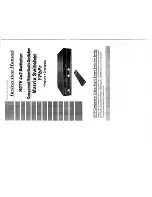
12
Description
Use
irf mac-address persistent
to configure IRF bridge MAC persistence so the IRF fabric continues to use
the bridge MAC address of the old master as its bridge MAC address for a period of time after a master
re-election.
Use
undo irf mac-address persistent
to disable IRF bridge MAC persistence so the IRF fabric changes its
bridge MAC address as soon as the master leaves.
By default, after the master device leaves, the IRF fabric continues to use its bridge MAC address as the
IRF bridge MAC address for six minutes.
An IRF fabric by default uses the bridge MAC address of the master device as its bridge MAC address.
This bridge MAC address is used by Layer 2 protocols, for example, LACP, to identify the IRF fabric, and
must be unique on a switched LAN for correct communication.
To avoid duplicate bridge MAC addresses, an IRF fabric can automatically change its bridge MAC
address after its master leaves. However, the change causes temporary service disruption. To avoid this
situation, configure bridge MAC persistence.
If two IRF fabrics have the same bridge MAC address, they cannot be merged into one IRF fabric.
If ARP MAD is used, you must use the
undo irf mac-address persistent
command to enable immediate
bridge MAC address change after the master leaves.
Examples
# Enable the IRF bridge MAC address to be permanent.
<Sysname> system-view
[Sysname] irf mac-address persistent always
irf member description
Syntax
irf member
member-id
description
text
undo irf member
member-id
description
View
System view
Default level
3: Manage level
Parameters
member-id
: Specifies the ID of an IRF member.
text
: Configures the IRF member description, a string of 1 to 127 characters.
Description
Use
irf member description
to configure a description for an IRF member.
Use
undo irf member description
to restore the default.
By default, no description is configured for any IRF member.
Examples
# Configure a description for IRF member 1.
<Sysname> system-view















































